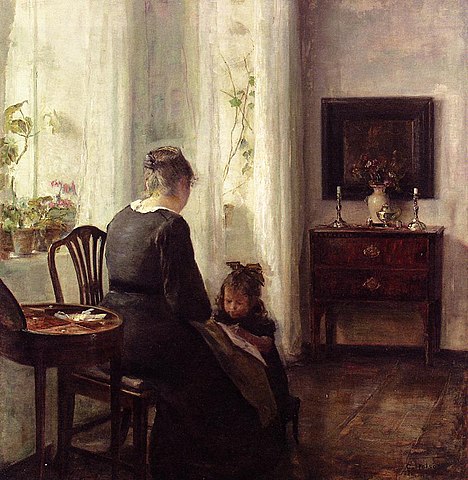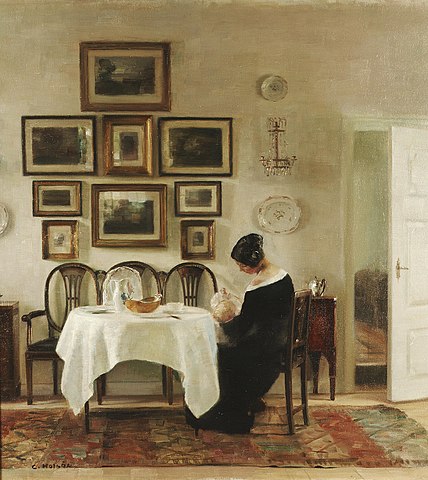
The Thammasat University Library has acquired a new book that should be useful for students interested in sociology, economics, philosophy, European studies, Scandinavia, Denmark, happiness studies, and related fields.
My Hygge Home: How to Make Home Your Happy Place is by Meik Wiking, a Danish researcher on the subject of happiness.
Hygge is a word in Danish and Norwegian that describes a mood of coziness and comfortable conviviality with feelings of wellness and contentment.
The TU Library collection also includes many other books about different aspects of happiness studies.
Hygge — pronounced hyoo-guh — is sometimes used to describe the comfort of being indoors on a warm day. As in Scandinavia, much of the year is cold and dark, warm, bright interiors are especially important.
Hygge may refer to socializing with family at home, feeling sheltered and safe, enjoying favorite foods, and soft lighting.
As the BBC reported in 2015,
Morley College, in central London, is teaching students how to achieve hygge as part of its Danish language course. “We have long, cold winters in Denmark,” says lecturer Susanne Nilsson. “That influences things. Hygge doesn’t have to be a winter-only thing, but the weather isn’t that good for much of the year.”
With up to 17 hours of darkness per day in the depths of winter, and average temperatures hovering around 0C, people spend more time indoors as a result, says Nilsson, meaning there’s greater focus on home entertaining.
“Hygge could be families and friends getting together for a meal, with the lighting dimmed, or it could be time spent on your own reading a good book,” she says. “It works best when there’s not too large an empty space around the person or people.” The idea is to relax and feel as at-home as possible, forgetting life’s worries. […]
“The rest of the world seems to be slowly waking up to what Danes have been wise to for generations – that having a relaxed, cosy time with friends and family, often with coffee, cake or beer, can be good for the soul,” says Helen Russell, author of The Year of Living Danishly: Uncovering the Secrets of the World’s Happiest Country. “Hygge seems to me to be about being kind to yourself – indulging, having a nice time, not punishing or denying yourself anything. All very useful come January when in the UK everyone’s on diets or manically exercising or abstaining from alcohol.
“There isn’t so much enforced deprivation in Denmark. Instead you’re kinder to yourselves and so each other. Danes don’t binge then purge – there’s not much yo-yo dieting in Denmark. No wonder they’re happier than we are in the UK.”
The adjectival form of hygge is “hyggeligt”, a word offered as a compliment to a host after a pleasant evening at their home.
“Hygge isn’t just a middle-class thing. Absolutely everyone’s at it from my dustbin man to the mayor,” says Russell. “Hygge is so crucial to living Danishly that the other day on the motorway, I saw a camper van driving along with lit candles in the windows. This is probably illegal but Vikings don’t tend to be too hung up on health and safety.

The author told an interviewer last year:
‘We spend more time than anywhere else in our homes — but how they impact how we feel has remained relatively unexplored,’ he tells Metro.co.uk. ‘Our research has found that our homes have a huge impact how we act and feel and as a Dane and a happiness researcher I am excited about exploring how to create homes where we not only live — but thrive.’
Our home and the architecture of happiness have been an overlooked aspect in how we try to improve our quality of life.
I work at the Happiness Research Institute, and one of the recent studies we’ve done looked at the connection between people’s homes and their overall happiness.
We looked at 13,000 participants across Europe, including the UK, and we can see that our satisfaction with a home is actually a big factor in how happy we feel overall. We found that 73% of the people who feel happy about their home also feel happy in general.
Our homes are where we re-energize to take on the world once more. In a world that sometimes seems to be increasingly turbulent and chaotic, demanding more and more of our attention and becoming ever more stressful, our homes are where we can retreat to and seek refuge.
Our homes have a huge impact on our happiness and wellbeing. […]
One study of kids who were born around the year 2000, and followed over time showed that if children had a TV in their bedroom at the age of seven had a 25% risk of obesity by the time they were 11. That’s just one simple change on how a room is decorated, which impacts on wellbeing.
With mental health, studies show that if you have inadequate daylight in your home, you have a 60% higher risk of depression. Light and lighting is very important. […]
The first step is changing your mindset. Right now, there’s a lot of turbulence in the world and an increase in anxiety.
It’s good to recognise that you have control over your home and creating a happy space there even though you can’t control a global pandemic or the invasion in Ukraine.
It’s important to focus on everyday happiness and everyday pleasures. Focus on what you can control. […]
Creating a happy family meal can have a positive impact on a whole range of areas. Families that sit down together and eat have fewer depression symptoms, lower obesity rates, better communication skills, better grades for the kids.
There’s also a cost of living crisis and home cooking is cheaper, healthier, and it can also be often done faster. So, if you want to have a happier home, eat together.
Also – become a ‘student of architecture happiness’. Start to be mindful of how different spaces make you feel.
Why is it that in one of your friend’s houses, you feel very relaxed and comfortable whereas in other places you may be more on the edge? Notice the elements. Ask yourself – what turns a house into a home?
Bring those elements in your own home. Consider how much time you spend in different locations and how the design and décor of those places impacts on your behaviour.

(All images courtesy of Wikimedia Commons)
